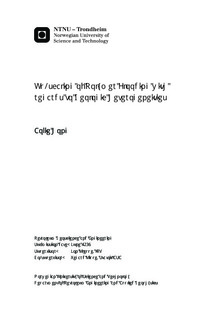| dc.description.abstract | Up-scaling of reservoir model is required to save computational time and costs in the industry. Due to numerical dispersion caused by enlarged grid size and reduced reservoir heterogeneity during up-scaling process, the simulation accuracy is reduced. This means that the simulation results on the coarse grid models cannot correctly represent the performance of polymer flooding. Although many up-scaling methods can be applied to reproduce fine grid simulation results on coarse grid models for water/oil flow, few studies take polymer flooding into account.Based on previous studies, it is found that the performance of polymer flooding is highly dependent on polymer solution viscosity and adsorption. In consideration of the effect of numerical dispersion on these two polymer properties, up-scaling factors of the polymer solution viscosity function (f_v) and of the polymer adsorption function (f_ad) are introduced in this thesis to tune coarse grid simulation results for polymer flooding. The aim of this study is to investigate the impact of up-scaling the polymer solution viscosity function and the polymer adsorption function on coarse grid simulation results in order to provide a simple up-scaling method for polymer flooding, and to investigate the impacts of flow dimension and heterogeneity on up-scaling. 1D, 2D and 3D, homogeneous and heterogeneous reservoir models are built and run in ECLIPSE in order to investigate how the values of f_v and of f_ad are affected by grid size and heterogeneity. Simulation results are summarized and analyzed in this thesis.The main conclusions in this study are concluded as follows: (1) the mismatches between fine and coarse grid simulation results of polymer flooding may be reduced by up-scaling the polymer solution viscosity function and the polymer adsorption function, (2) different from water/oil flow, the simulated history of oil recovery can be tuned without touching the relative permeability curves by up-scaling the polymer solution viscosity function and this may be an advantage, (3) the accuracy of predicting polymer loss by doing simulation on a coarse model for a polymer flooding project may be improved by simply up-scaling the polymer adsorption function, (4) increases of flow dimension and of heterogeneity affect significantly up-scaling of the polymer solution viscosity and the polymer adsorption functions, (5) some limitations of this up-scaling method are found and one of them is that too high injector WBHP may appear in some particular cases, and (6) the up-scaling method introduced in this thesis is not a robust method and many other affecting factors have to be consider in further studies. | nb_NO |

